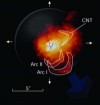 A cocktail of chemicals is venting in enormous jets from the oxygen-rich surroundings of a supergiant star 5000 light years from earth, according to Arizona radio astronomers. Using the the Arizona Radio Observatory’s 10m Submillimeter Telescope (SMT) on Mount Graham, which is so sensitive it could detect emissions from deep space that are weaker than a typical light bulb, the team has picked up the chemical signatures for a range of small molecules and ions.
A cocktail of chemicals is venting in enormous jets from the oxygen-rich surroundings of a supergiant star 5000 light years from earth, according to Arizona radio astronomers. Using the the Arizona Radio Observatory’s 10m Submillimeter Telescope (SMT) on Mount Graham, which is so sensitive it could detect emissions from deep space that are weaker than a typical light bulb, the team has picked up the chemical signatures for a range of small molecules and ions.
Among the score of small chemical species detected in the environment around the supergiant star VY Canis Majoris is common salt (NaCl), hydrogen isocyanide, phosphorus nitride, and protonated carbon monoxide ions. These materials contain several of the elements critical to the formation of life, explain the researchers, something that was not expected to be found in the atmosphere of a cool dying star.
“I don’t think anyone would have predicted that VY Canis Majoris is a molecular factory. It was really unexpected,” says Arizona chemist Lucy Ziurys, Director of ARO, “Everyone thought that the interesting chemistry in gas clouds around old stars was happening in envelopes around much closer, carbon-rich stars.
We are all made of stars, but whether or not this latest evidence points to a stellar origin for life on earth remains to be seen. Apparently, comets and meteorites dump about 40,000 tonnes of interstellar dust on our planet each year, presumably this figure was much higher when the earth was mere millions of years old and given that most of its original carbon evaporated away from its primordial methane atmosphere it is very possible that we do indeed owe our existence to a heavenly body.
You can read my full write-up on this over on SpectroscopyNOW.com